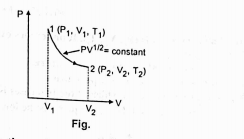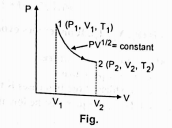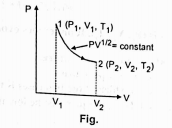Complete Solutions to EXAMPLE of chapter Thermodynamics of Class 11 book with complete answers and questions
| Class 11 | PHYSICS |
| Chapter | Thermodynamics |
| JBD PUBLICATION | EXAMPLE |
| Number Of Questions | 69 |
| Academic Year | 2023-24 |
Which state of matter has the greatest and least internal enrgy having the same mass and same temperature?
01:49View SolutionTwo systems are said to be in thermal equilibrium with each other, if they are at the same________.
01:04View SolutionIs it true to say that a body at higher temperature contains more heat?
01:11View SolutionOn what factors does the internal energy of an ideal gas depend?
01:28View SolutionWhat do you mean by thermodynamical state?
01:22View SolutionWhat is the importance of a absolute scale of temperature?
01:19View SolutionDefine thermodynamical variables, equation of state
02:02View SolutionIs it possble to devise a heat engine which will create no thermal pollution?
01:33View SolutionWhat is change in internal energy in isothermal process?
01:35View SolutionDoes the internal energy of an ideal gas change in an adiable process?
01:44View SolutionWhat is the signifiance of the indicatyor diagram or PV-diagram?
02:04View SolutionIs boiling of water at normal pressure an isothermal process or adiabatic process?
01:25View SolutionWhat is nature of PV-diagram for a cyclic process?
01:52View SolutionIf `gamma` denotes the ratio of specific heats `(C_p//C_v)` of a gas,then the ratio of slopes of adiabatic to isothermal on P-V curve at their point of intersection is :
02:00View SolutionWhat are values of isothermal and adiabatic elasticities of a gas?
02:16View SolutionWhich type of motion of molecules of monoatomic gas is responsible for its internal energy?
01:12View SolutionA volume of gas at atmospheric pressure is compressed adiabatically to half its original volume. Calculate the resulting pressure `(gamma = 1.4)`
02:20View SolutionWhat is work done by a gas in isochoric process?
01:37View SolutionOn what factors does the internal energy of an ideal gas depend?
01:28View SolutionOn what factors does the effeciency of Carnot'sheat engine depend?
01:13View SolutionWhy efficiency of ideal heat engine cannot be 100%?
01:21View SolutionGive an exxamle of heat pump.
01:20View SolutionRefrigerator transfers heat from a cold body(from inside) to hot body(outside atmosphere).Does it violate second law of thermodynamies?
01:42View SolutionFrom the indicator diagram find an expression for work done in a cyclic process.
03:30View SolutionWhat is relation between the efficiency of heat engine `(eta)` and coefficient of performance `(alpha)` of refrigerator?
01:29View SolutionDefine critical temperature.
02:27View SolutionWhat is critical temperature and critical pressure of water?
01:29View SolutionWhat is a phase diagram?
01:40View SolutionWhat is the value of triple point of water?
01:29View SolutionCan we distinguish between the nternal energy of a body acquired by heat transfer or work done by external agent?
01:51View SolutionState second law of thermodynamics ?
01:44View SolutionExplain adiabatic process on the basis of first law of thermodynamies.
01:38View SolutionA thermodynamic system is taken from an original state to an intermediate state by the linear process shown in Fig. (12.13) Its volume is then reduced to the original value from E to F by an isobaric process. Calculate the total work done by the gas from D to E to F :
 02:07View Solution
02:07View SolutionA refrigerator isto maintain eatables kept inside at `9^@C`. If room temperature is `36^@C`, calculate the coefficient of performance.
01:50View SolutionTwo cylinders A and B of equal capacity are connected to each other via a stopcock. A contains a gas at standard temperature and pressure. B is completely evacuated. The entire system is thermally insulated. The stopcock is suddenly opened. Answer the following : What is the final pressure of the gas in A and B ?
04:17View SolutionTwo cylinders A and B of equal capacity are connected to each other via a stopcock. A contains a gas at standard temperature and pressure. B is completely evacuated. The entire system is thermally insulated. The stopcock is suddenly opened. Answer the following : What is the change in internal energy of the gas ?
01:59View SolutionTwo cylinders A and B of equal capacity are connected to each other via a stopcock. A contains a gas at standard temperature and pressure. B is completely evacuated. The entire system is thermally insulated. The stopcock is suddenly opened. Answer the following : What is the change in the temperature of the gas ?
02:04View SolutionTwo cylinders A and B of equal capacity are connected to each other via a stopcock. A contains a gas at standard temperature and pressure. B is completely evacuated. The entire system is thermally insulated. The stopcock is suddenly opened. Answer the following : Do the intermediate states of the system (before settling to the final equilibrium state) lie on its P-V-T surface ?
02:49View SolutionA geyser heats water flowing at the rate of 3.0 litres per minute from `27 ^@C` to `77 ^@C`. If the geyser operates on a gas burner, what is the rate of consumption of the fuel if its heat of combustion is `4.0 xx 10^4 J//g` ?
03:47View SolutionWhat amount of heat must be supplied to `2.0 xx 10^-2 kg` of nitrogen (at room temperature) to raise its temperature by `45 ^@C` at constant pressure ? (Molecular mass of `N_2 = 28, R = 8.3 J mol^-1 K^-1.`)
02:32View SolutionExplain why Two bodies at different temperatures `T_1 and T_2` if brought in thermal contact do not necessarily settle to the mean temperature `(T_1+T_2)//2`.
03:46View SolutionExplain why The coolant in a chemical or a nuclear plant (i.e., the liquid used to prevent the different parts of a plant from getting too hot) should have high specific heat.
02:27View SolutionExplain why Air pressure in a car tyre increases during driving.
02:08View SolutionExplain why The climate of a harbour town is more temperate than that of a town in a desert at the same latitude.
04:21View SolutionCarnot engine takes in a 3thousand kilocalories of heat from a eservoir at `627^@C` and exhausts it to a sink at `27^@C`How much work does it perform?
02:11View SolutionCarnot engine takes in a thousand kilocalories of heat from a eservoir at `627^@C` and exhausts it to a sink at `27^@C`.What is its efficiency ?How much work does it perform?Express it in
kilowatt-hour02:55View SolutionCarnot engine takes in a thousand kilocalories of heat from a eservoir at `627^@C` and exhausts it to a sink at `27^@C`.What is its efficiency ?How much work does it perform?Express it in
electron-volt.03:21View SolutionA Carnot engine having sink at `27^@C` has an efficiency of 40%.It is desired to increase the efficiency of 10%.By how many degrees the temperature of the source has to be increased?
01:59View SolutionFind the work required to compress adiabatically 1 g of air initally at N.T.P. to half its volume.Density of air at N.T.P.=0.00129 `g//cc` and `gamma = 1.4`.
03:20View SolutionA tyre is pumped to a pressure of 3.375 atmospheres and at `27^@C` suddently bursts.What is the final temperature?`(gamma=1.5)`.
02:22View SolutionAssuming a domestic refrigerator a reversible engine working between melting point of ice and the room temperature of `17^@C`.Calculate the enrgy in joule that m ust be suppled to freeze 2kg of water .Given that temperature of water`= 0^@C ` nd `L=80 cal//g`.
02:17View SolutionGive two statements of second law of thermodnamics.
02:27View SolutionWrite short note on cyclic process.
01:56View Solution5 moles of oxygen are heated at constant volume from `10^@C` ot `20^@C`.What will be the change in the internal enregy of the gas?The molar specific heat of oxygen at constant pressure is `C_p=7.03 cal mol^(-1) deg^-1` and `R=8.36 Joule mol^(-1) "^oC^(-1)`.
02:25View SolutionThe molar heat capacity of a gas at constant volume is to be `5 cal mol^(-1) K^(-1)`.Find the ratio `gamma=C_p // C_v` for the gas.The gas constant `R=2 cal mol^(-1) K^(-1)`.
01:45View Solution0.32 g of oxygen is kept in a rigid container and is heated .Find the heat energy needed to raise the temperature from `25^@C` to `35^@C`.The molar heat capacity of oxygen at constant volume is `20 J mol^(-1) K^(-1)`.
01:43View SolutionWhat do you understand by isobaric and isochoric process?
01:36View SolutionWhat is the relation between `C_P` and `C_v`?
01:09View SolutionHow can you explain that `C_p` is greatere than `C_v` ?
01:53View SolutionWrite detail of specific heats of gases.
02:18View SolutionA gas expands in such a manner that its pressure and volume comply with the condition `pV^2 = a` constant .Will the gas cool or get heated on expansion?
02:24View SolutionA gas occupying one litre at 80 cm pressure is expanded adiabatically to 1190 cc.If the pressure falls to 60 cm in the process ,deduce the value of `gamma`.
03:10View SolutionIf at `50^@C` and 75 cm of mercury pressure , a definite mass of a gas is compressed slowly, then what will be the final pressure and temperature of the gas if the final volume is one-fourth of the initial volume?
01:57View SolutionWrite short note on thermal equilibrium.
01:39View SolutionConsider a PV-diagram in which the path followed by one mole of perfect gas a cylindrical container is shown in (fig.).

Find the work done when the gs is taken from state 1 to state 2.01:51View SolutionConsider a PV-diagram in which the path followed by one mole of perfect gas a cylindrical container is shown in (fig.).
 What is the ratio of temperature `T_1 // T_2` ,if `V_2 = 2V_1`?02:16View Solution
What is the ratio of temperature `T_1 // T_2` ,if `V_2 = 2V_1`?02:16View SolutionConsider a PV-diagram in which the path followed by one mole of perfect gas a cylindrical container is shown in (fig.).
 Given to internal enregy for one mole of gas at temperature T is `(3 // 2)` RT,find the heat supplied to the gas when it is taken from state 1 to 2,with `V_2=2V_2`.05:06View Solution
Given to internal enregy for one mole of gas at temperature T is `(3 // 2)` RT,find the heat supplied to the gas when it is taken from state 1 to 2,with `V_2=2V_2`.05:06View SolutionThe initial state of a certain gas is `(P_i,V_i,T_i)`. It undergoes expansion till its volume becomes `V_f` Consider the following case.
the expansion takes place at constant temperature. Plot the P-V diagram.02:23View SolutionThe initial state of a certain gas is `(P_i,V_i,T_i)`. It undergoes expansion till its volume becomes `V_f` Consider the following case.
The expansion takes place at constant pressure. Plot the P-V diagram.01:40View Solution
EXAMPLE questions and complete solutions for chapter Thermodynamics of JBD PUBLICATION of Class 11
